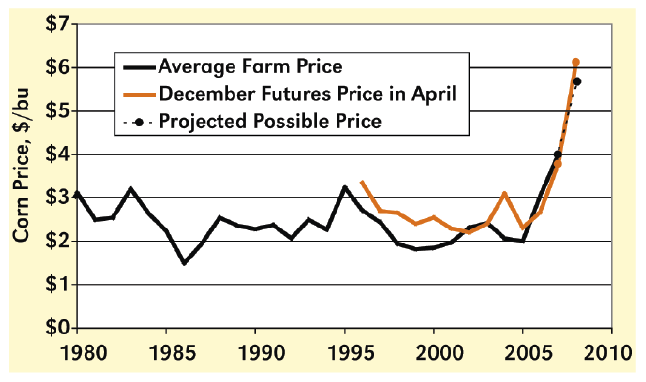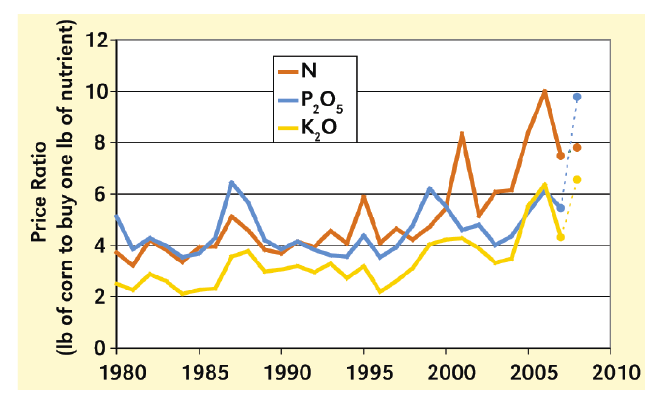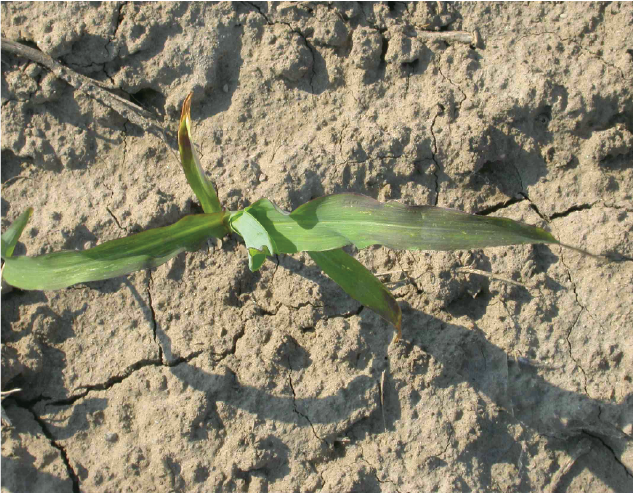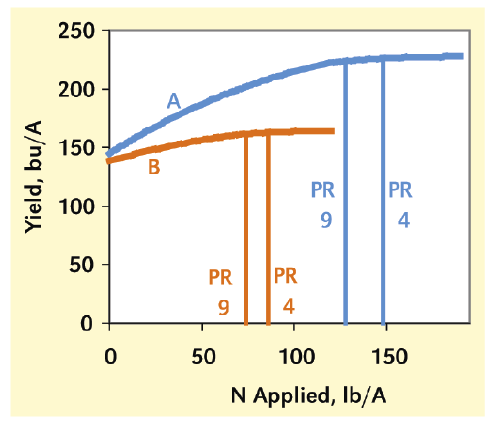
Features
Fertilizer
Seed & Chemical
Corn fertilizer decisions in a high-priced market
When prices are high for both fertilizers and corn, producers will be
rewarded for spending more time on fertilizer decisions, using the
tools developed by science to determine the right product, rate,
timing, and placement.
April 20, 2009 By by Tom W. Bruulsema and T. Scott Murrell. Reprinted from Better Crops with Plant Food
 |
|
| Producing high yields with high populations requires the right fertilizer decisions.Photos courtesy of International Plant Nutrition Institute |
When prices are high for both fertilizers and corn, producers will be rewarded for spending more time on fertilizer decisions, using the tools developed by science to determine the right product, rate, timing, and placement.
Markets have taken the prices for corn and fertilizers to places they have never been. How does this influence management decisions for the right product, the right rate, the right timing, and the right placement?
Background
Price variations for the three main fertilizer ingredients from 1980 to 2000 are dwarfed by the increases since then (Figure 1), with the largest increase occurring between 2007 and 2008. Phosphate fertilizer prices shot up most dramatically in the past year.
Prices received for corn have varied more than prices paid for fertilizer (Figure 2), and have increased rapidly from a low level in 2005. The average price producers will receive for the 2008 crop is as yet unknown, but with December 2008 futures trading above $6 per bushel in April 2008, many producers are likely to receive substantially more than the $3.25 to $4.00 they received in 2007. The projected possible price is based on correlation with Chicago December futures in April from 1996-2007. It is not a prediction, but an assumption for purposes of the analysis that follows.

|
|
| Table 1.Price ratios associated with various prices of corn and fertilizer N (pounds of corn equal in value to one pound of N). |
|
 |
|
| Figure 1. Average farm prices of fertilizer nutrients up to April 2008. Calculated from USDA-ERS data. | |
 |
|
| Figure 2. Average farm prices received for corn (USDA-NASS, 1980-2007) and April price for Chicago December futures from 1996-2008. |
|
 |
|
| Figure 3. Ratio of fertilizer nutrient prices shown in Figure 1 to corn prices in Figure 2, expressed as pounds of corn required to purchase one pound of nutrient (1980-2008). Note that estimates shown for 2008 are hypothetical since they depend on the currently unknown 2008 average corn price.
|
|
 |
|
| Starter fertilizer can efficiently prevent deficiencies in seedlings. Photo credit to the International Plant Nutrition Institute. |
|
 |
|
| Figure 4. Increasing price ratio (PR) from 4 to 9 diminishes the optimum N rate. Site A (Below, 2007). Site B – 2005 data from Ontario Ministry of Agriculture, Food and Rural Affairs staff.
|
The price ratio between fertilizer and the crop determines the short-term profit resulting from fertilizer use. It influences optimum rates for N, P and K, as discussed later in Section 3. We express the ratios in pounds of corn grain required to purchase a pound of fertilizer nutrient. This is calculated as the fertilizer nutrient price ($/lb) divided by the corn price ($/lb, which is $/bu ÷ 56 lb/bu). Expressed this way, a higher ratio means relatively more expensive fertilizer. Note that others may express price ratios differently, resulting in a figure representing bushels of corn equal in value to a pound of fertilizer, or its reciprocal. Table 1 shows the price ratios associated with various combinations of corn and fertilizer N prices. Historical variations shown in Figure 3 cover a much narrower range than those in the table, because corn and fertilizer prices tend to go up and down together. If the average corn price for 2008 indeed turns out to be $5.67/bu, only the P price ratio would currently be at the high end of its historical range. Even so, its price ratio would not differ greatly from those endured in 1999 and 1986. The price ratios for N and K would be down substantially from the highs of 2005.
Overall, there is an increasing trend in these price ratios over the past 38 years. This might be expected in the context of a fertilizer industry reliant on fossil fuel resources, and a corn production industry in which yields are increasing faster than fertilizer application rates.
Managing by the Four Rights
Right Product
With higher prices for fertilizer nutrients, it becomes more important to use the product that provides the highest efficiency. Premiums previously considered unaffordable now become cost-effective. Controlled-release sources, or those with inhibitors slowing down the conversion to nitrate, can more efficiently deliver nutrients to the plant, provided they are applied in situations where their nutrient release matches the uptake needs of the crop.
Are these products always better than split application? Ongoing research is still needed to determine when they are or are not. A split application of soluble fertilizer entails different risks than those associated with a single application of a controlled-release product. The soil may be too wet at side-dress time to get on to the field. Or, in some years, soils may be so dry that side-dressed N, even in fluid form, does not get to the roots. Split applications also entail extra fuel costs. Controlled-release products can potentially be more reliable and more convenient. But weather and many other soil factors can influence the rate of release, so it is important to evaluate which product performs best in your own specific growing conditions. Limited research has been done on these products, so a combination of searching out relevant results and conducting on-farm trials is called for.
Price changes may affect some products more than others. Compare price per pound of N as anhydrous ammonia, urea, urea-ammonium nitrate, ammonium sulfate, ammonium nitrate, calcium nitrate, and potassium nitrate. But also make sure the product suits the application method. Avoid leaving urea or urea-ammonium nitrate on the soil surface.
Right Rate
Corn yield typically shows a diminishing response as the rate of N applied increases. The economically optimum rate occurs where the yield increase no longer pays for the last increment of fertilizer. As price ratio increases, the optimum rate decreases. Figure 4 compares two examples: a site in Illinois with a high-yielding hybrid in 2006, and a site with lower yield potential in Ontario in 2005. In both these cases, increasing the price ratio from four to nine decreases the optimum rate by about 14 per cent. The Ontario N Calculator (Stewart, 2007) recommends a reduction of 30 lbs/ac for an increase in price ratio of this magnitude.
When prices for both corn and fertilizer increase proportionally, the optimum rate does not change, but the consequences of a non-optimal rate are more costly. It becomes more important to use every means at your disposal to get the best estimate possible of the optimum rate. For N, this can be difficult. A pre-sidedress soil nitrate test (PSNT), taken when the corn is six to 12 inches tall, can help guide decisions on sidedress N applications. For an in-season assessment, a SPAD meter (chlorophyll meter) has proven effective and many universities provide guidance on using it. For an end-of-season assessment, stalk nitrate tests are recommended by many institutions.
For nutrients less mobile than N, like P and K, increasing price ratios may lead to a change in approach to determining application rates. Soils built up in fertility to levels with response probabilities below 50 percent are often fertilized only for maintenance. A short-term strategy of reduced application rates is not likely to greatly reduce yield and profit. However, the consequent decline in soil fertility for future crops needs to be considered.
Price ratio does not alter the amount of P or K that corn removes from the soil. Higher price ratios increase the profitability of sound soil testing to identify fields and areas within fields where rates below removal may be justified for one or several years. But in the long term, nutrients removed will need to be replaced.
Right Timing
When fertilizer prices rise, and the extra cost associated with a better application system stays the same, the benefit:cost ratio may increase to make a different system cost-effective.
Generally, spring is a more effective time than fall to apply N for corn. Typically, a fall application carries a risk that it will be less effective. At its best, fall application can only equal the effectiveness associated with spring application. Fall applications are made to manage other risks, primarily logistical ones. Fall applications take advantage of typically drier soil conditions and more available field days compared to the spring. They also allow some of the tasks to be moved from a busy spring to a less busy fall, increasing the chances that the spring tasks will be timely.
In the western Corn Belt, high fertilizer prices may favor an investment in equipment to apply N in the spring rather than in the fall. Nitrogen should only be applied in the fall after the average daily soil temperatures at four to six inches deep (measured mid-morning) go below 10 degrees C (50 degrees F) and are sustained at or below this for the winter.
In Iowa (Sawyer, 2006), preliminary fall application research with controlled-release urea products (PCU), has indicated an average 4.0 bu/ac corn yield increase compared to fall-applied urea. However, the fall-applied PCU produced 4.0 bu/A less yield compared to spring-applied urea: an 8.0 bu/ac yield advantage for spring- versus fall-applied urea. In the eastern Corn Belt, fall-applied N is unreliable and inefficient. Even spring applications are often better applied split, with some at planting and the largest part in June when the corn is about six inches tall. There are two things you can estimate more accurately in June than at planting: one, the soil’s ability to supply N, and two, the crop’s potential need. While corn doesn’t take up much for the first month after it emerges, it needs a good supply from the start. Applying the smaller part at planting and a larger dose in June maximizes yield and efficiency.
Right Placement
Corn has a special need for P early in the growing season. Phosphorus speeds maturity and can help lower grain drying expenses. Placement with the seed in small amounts, and near the seed in larger amounts, provides maximum availability to the young seedling. Applying it in bands below the soil surface reduces the risk of it moving to water by surface runoff.
Assess possibilities for with-seed and band placement. Corn responds most to P when its seedlings are young. Placement near the seed ensures access by the young seedlings, and placement in a band concentrates the nutrient to minimize fixation by the soil. Research suggests that combinations of N and P work most effectively, and that K is an important component of starter fertilizer for corn grown with reduced or no tillage (Vyn et al., 2002). Small amounts of a P-rich fertilizer placed with the seed of corn can provide an additional yield benefit (Lauzon and Miller, 1997). However, rates placed with the seed should be kept very low and will not be sufficient to replace crop removal.
Incorporate or inject volatile sources of N. When N sources containing urea or ammonium (urea, urea-ammonium nitrate, anhydrous ammonia, ammonium nitrate, and ammonium sulfate) are surface applied without incorporation, ammonia losses can be high. Loss can be minimized by incorporating the fertilizer into the soil as soon as possible.
Conclusion
Every farm and field is different. As a producer, you need to be able to select the best management practices suited to your conditions. Even in the context of high prices, managing corn nutrition right means more than applying the minimum to get an average crop. The manager needs to consider the best choices for product, rate, timing, and placement to keep the corn crop productive.
Dr. Tom Bruulsema is IPNI Northeast Region Director, located at Guelph, Ontario. Dr. Murrell is IPNI Northcentral Region Director, located at West Lafayette, Indiana.